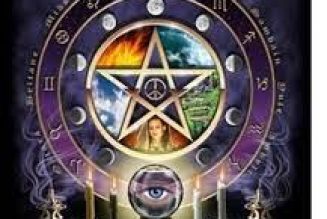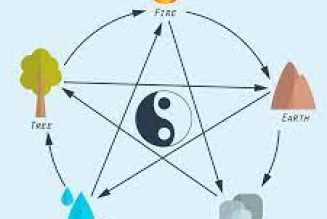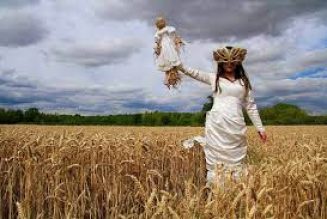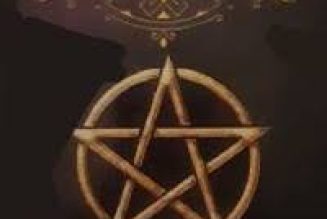Witchcraft is as old as the human race. It dates from the days when, by the flickering light of a clay lamp, a Stone Age artist worked in the silent depths of a cave sanctuary, drawing upon the walls the great beasts he hunted for his food.
Sometimes he depicted the beasts with arrows and spears in them, in order to gain power over them by sympathetic magic.
Sometimes he showed them in sexual union; because unless they mated freely and had abundant young the herds would diminish and he would be hungry.
Fertility of animals and humans was all he knew; farming had not yet been evolved.
The mysterious principle of life worked in Nature, and carried on the world ; a world of forests and plains, of chasing great beasts more powerful than himself, of the safety of the dark cave and
the warmth of the blazing fire ; a world where fire, water, the seasonchanging earth and the wide air, full of stars at night, were indeed the elements of life.
For him the moon waxed and waned, filling the night with ghosts and shadows, and manifestly ruling women in the cycle of their creative life, bringing each month either the magic moon-blood or a waxing of their womb, until a new baby appeared.
Woman was the vessel of fertility, the vessel of life.
The first known artistic works of humanity are little figurines representing a nude and pregnant woman.
Some of them are carved from mammoth ivory, others from stone.
They are beautiful, dignified, remote.
Beside them the Pyramids are things of yesterday.
They are not portraits.
They represent rather the abstract principle of fertility, of life itself; a goddess of fertility, man’s most primeval object of worship.
Because woman contained life, she also contained magic.
From Algeria comes a very interesting Paleolithic drawing on stone.
One might even call it the earliest known picture of a witch. It depicts a woman standing with upraised arms, in an attitude of invocation.
From her genital region a line runs across to the genitals of a man ; he is shown half-crouched, and in the act of releasing an arrow from a bow.
Around him are animals, and the arrow is being aimed at a large bird which looks like an ostrich.
This is obviously a scene of hunting magic ; the woman at home in her cave or hut, practising witchcraft to enable her man to kill game for their food.
The drawing, though primitive, is done with a true artist’s hand.
The tension in the man’s figure, the cautious hunter closing in for the kill, and the woman’s earnest invocation, are well conveyed.
She is depicted rather larger than the man, to give her importance, and seems to be wearing some magical jewellery, a girdle and some dangling amulets on either arm.
Upraised arms as an attitude of prayer and invocation are frequently seen in very ancient art.
Another remarkable picture that has come down to us from those twilight centuries of Stone Age time, is the famous ‘Sorcerer’ from the Caveme des Trois Freres, in Ariege, France.
This depicts a dancing figure, half-man, half-beast, with the spreading horns of a stag.
Some authorities regard this as a masked man, others as a Homed God.
Margaret Murray describes this picture as “The earliest known representation of a deity” ; but I believe the fertility goddess figurines, referred to above, are now thought to be older.
The naked goddess of life and fertility, and the Horned God, are still the deities worshipped and invoked by witch covens today. Of course, this does not prove a direct inheritance from Stone Age times, except that which we all bear in the deepest levels of our minds.
Nevertheless, witchcraft is certainly not the invention of superstitious churchmen in the Middle Ages, as some writers would have us think.
Witches very like those of the Middle Ages were known to the Ancient Greeks and Romans. Lucius Apuleius wrote about them.
So did Virgil, Pliny, Theocritus, Petronius Arbiter, Horace, Lucan and Tibullus. Medea and Circe were regarded as witches. Ovid describes Medea as using wax images to cause harm to the people
they represented, and Diodorus calls her Hecate’s own daughter.
Hecate was the Ancient Greek goddess of witchcraft. (How could the Ancient Greeks have had a goddess of something which did not exist until the Middle Ages invented it ?)
However, by the time of the classical writers, witchcraft had come to be feared as something rather uncanny, and not respectable to meddle with.
It belonged to an older stratum of society, before the polished urban civilisation of Rome ; even though the latter, in popular orgiastic rites such as the Floralia and the Lupercalia, retained distinct traces of more primitive times.
Witchcraft belonged to the old half-forgotten days of the primeval matriarchy, when woman who tended the hearth-fire and stirred the cooking-pot was the first ‘wise one’, the seeker of herbs and binder of wounds, the seer of pictures in the fire, the hearer of voices in the wind, the interpreter of dreams and the caster of painted stones for divination, the worker of magic for hunting, and of the greatest magic of all, the magic of life.
Witches were the descendants of the Wild Women who had sacrificed the Divine King, when his term of office was fulfilled, so that his blood might fertilise the land. Their magic was both dark and bright, like the Moon Goddess they served.
But the time came when the masculine idea and the male gods began to rise and challenge the supremacy of the Goddess Mother of Nature.
Kings began to insist on ruling in their own right, instead of by favour of the goddess; nor would they accept a sacrificial death.
Descent began to be traced through the father, instead of through the mother.
Men began to arm themselves with stronger weapons, and war and conquest were glorified.
Laws and customs that tended to repress the dangerous powers of the feminine side of things came into existence.
Men took over the chief places of the priesthood, and organised religions that exalted the male side of deity.
The older, deeper things of religion found their way into the Mystery Cults.
These endured because they appealed to something within the human soul that felt a kinship with magic and mystery ; for the same reason that witchcraft and the fascination of the occult endure today.
With the coming of Christianity according to St. Paul, the takeover was complete.
Women were told to keep silent in church, that they should be ashamed to be female, that sex was unclean.
The pagan Mysteries were forbidden in the fourth century A.D., and their priests and priestesses denounced as sorcerers.
From then onwards, the underground organisation of witchcraft began to take shape.
So too did the various abominations witches were accused of.
Black witchcraft had always existed. Lucan’s Erichtho, and Horace’s Canidia and Sagana, are terrifying hags who take part in horrible rites involving blood sacrifice and desecrated graves.
But now came the complete refusal to recognise any other side of the coin.
All witchcraft was declared to be black, because the old gods were devils; so their servants must be devil-worshippers. (One finds the same outlook among some writers today).
The common people, however, tended to cling obstinately to the old ways; and there was a long transition period in Europe before the Christian Church finally gained the upper hand, which it did more by force than by popular vote.
The first English writer to recognise that the witches’ Sabbats were simply the continuation of the old popular Nature worship, more or less clandestinely, into Christian times, was the distinguished antiquarian, Thomas Wright.
In 1 865 a new edition, privately printed, was published of Richard Payne Knight’s Discourse on the Worship of Priapus, to which was now added another essay, “On the Worship of the Generative Powers during the Middle Ages of Western Europe”.
Owing to Victorian prudery, the book had to be privately printed; and Wright, remembering the storm of denunciation which had broken on the head of Payne Knight when his book first appeared in 1 786, prudently refrained from adding his name to the work.
The book was for many years classed as something to be sold under the counter, and only recently has it begun to receive the recognition it deserves, as an original piece of research.
Meanwhile, all the old fables of hell-fire and devil-worship continued to be told about witchcraft.
People did not mind hearing about Satan; but sex was really something terrible !
Briefly, the thesis contained in these two essays is that the worship of the powers and means of fertility by the ancient peoples of the world was in reality neither obscene nor depraved.
It was the worship of the fundamental power of Life itself, animating the universe, and bringing forth all the things of Nature in their wonderful beauty and diversity.
When the early Christian Church came under the influence of fiercely sex-hating puritans and ascetics, this old worship and its rituals, dear to the common people, were driven underground, and gave rise to the cult of witchcraft as we know of it today.
Historically and psychologically, this theory makes sense.
We have to remember that people died because they would not renounce the ‘heresy’ of witchcraft. When people die for a faith, that faith exists.
We know that in the full hysteria of witch-hunting that gripped men’s minds in the Dark Ages, many people perished who were not witches at all ; but this was not always so.
Nor did people risk persecution and even death to attend the Sabbats, if the Sabbats were the impossible farrago of horrors that official propaganda represented them to be.
People went to the Sabbats for a perfectly understandable reason ; they enjoyed them.
They carried on the witch cult for a perfectly understandable reason ; it was a different religion from orthodox Christianity, with a very different outlook, and they preferred it.
Thomas Wright regarded the witches’ Sabbat as being mainly derived from the Roman traditions of the Priapeia and the Liberalia, festivals of orgiastic Nature worship.
Today, however, we have a wider knowledge of ancient religions; and we know that in fact the ideas behind the worship of the Life principle are fundamental to them all, in both East and
West.
The Chinese formulated their philosophy of the interplay of Yang and Yin, the masculine and feminine principles of Nature.
The original Shiva of the Hindus was an ithyphallic horned god, whose representations, found in the prehistoric city of Mohenjo-daro, bear a curious resemblance to the Celtic horned god.
Cernunnos.
In some of them, he even has something which looks like a candle or torch between his horns, the very attribute of the Devil of the Sabbat.
Margaret Murray, in her famous book The Witch Cult in Western Europe (Oxford Paperbacks, 1 962}, draws an important distinction between Operative Witchcraft and Ritual Witchcraft.
Under Operative Witchcraft she classes charms and spells of all kinds; but Ritual Witchcraft is witchcraft as a system of religious belief and ceremony.
The very fact that witchcraft needs to be so divided is another pointer to its great antiquity.
In the beginning, religion and magic were two aspects of the same thing, the belief in numinous, unseen powers, both inherent in Nature and transcending Nature.
Only slowly and lately did the division between religion and magic take place.
The original priest was also a magician ; and before the priest was a priestess, who was also a witch.







